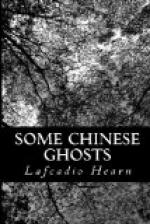KABIT.—A poetical form much in favor with composers of Hindoo religious chants: the kabit always consists of four verses.
KAO-LING.—Literally, “the High Ridge,” and originally the name of a hilly range which furnished the best quality of clay to the porcelain-makers. Subsequently the term applied by long custom to designate the material itself became corrupted into the word now familiar in all countries,—kaolin. In the language of the Chinese potters, the kaolin, or clay, was poetically termed the “bones,” and the tun, or quartz, the “flesh” of the porcelain; while the prepared bricks of the combined substances were known as pe-tun-tse. Both substances, the infusible and the fusible, are productions of the same geological formation,—decomposed feldspathic rock.
KASI (or VARANASI).—Ancient name of Benares, the “Sacred City,” believed to have been founded by the gods. It is also called “The Lotos of the World.” Barth terms it “the Jerusalem of all the sects both of ancient and modern India.” It still boasts two thousand shrines, and half a million images of divinities. See also Sherring’s “Sacred City of the Hindoos.”
KIANG-KOU-JIN.—Literally, the “tell-old-story-men.” For a brief account of Chinese professional story-tellers, the reader may consult Schlegel’s entertaining introduction to the Mai-yu-lang-tou-tchen-hoa-kouei.
KIN.—The most perfect of Chinese musical instruments, also called “the Scholar’s Lute.” The word kin also means “to prohibit”; and this name is said to have been given to the instrument because music, according to Chinese belief, “restrains evil passions, and corrects the human heart.” See Williams’s “Middle Kingdom.”
KOUEI.—Kouei, musician to the Emperor Yao, must have held his office between 2357 and 2277 B.C. The extract selected from one of his songs, which I have given at the beginning of the “Story of Ming-Y,” is therefore more than four thousand years old. The same chant contains another remarkable fancy, evidencing Chinese faith in musical magic:—
“When I smite my [musical]
stone,—
Be it gently, be it strongly,—
Then do the fiercest beasts
of prey leap high for joy.
And the chiefs among the public
officials do agree among themselves.”
KWANG-CHAU-FU.—Literally, “The Broad
City,”—the name of
Canton. It is also called “The City of
Genii.”
LI.—A measure of distance. The length of the li has varied considerably in ancient and in modern times. The present is given by Williams as ten li to a league.
LI-SAO.—“The Dissipation of Grief,” one of the most celebrated Chinese poems of the classic period. It is said to have been written about 314 B.C., by Kiu-ping-youen, minister to the King of Tsou. Finding himself the victim of a base court-intrigue, Kiu-ping wrote the Li-Sao as a vindication of his character, and as a rebuke to the malice of his enemies, after which he committed suicide by drowning.... A fine French translation of the Li-Sao has been made by the Marquis Hervey de Saint-Denys (Paris, 1870).




